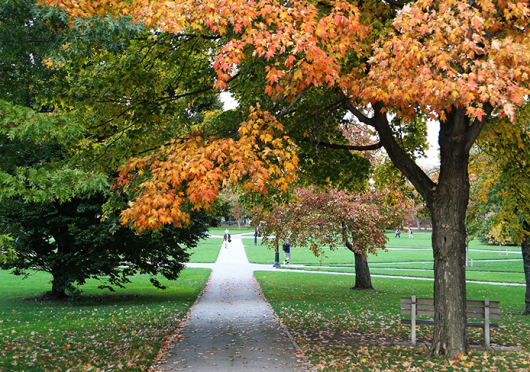
OSU was recently recognized by Tree Campus USA in 2014 for its efforts to promote conservation about forestry and engaging community members in educational opportunities. Credit: Mark Batke / Photo editor
There are hundreds of trees on Ohio State’s campus that can be easily overlooked, especially during winter, but to Beth Ritterholz, forestry is a topic of conversation on a daily basis.
Ritterholz is a tree inventory student worker at Chadwick Arboretum, located across the street from the Schottenstein Center. She and her colleagues make sure that OSU is certified for Tree Campus USA, a nationwide program created by the Arbor Day Foundation that started in 2008 and recognizes colleges and universities for promoting sustainability and conservation.
OSU was recently recognized by Tree Campus USA in 2014 for its efforts to promote conversation about forestry and engaging the community in the topic. There are five criteria that go into being recognized, said Steve Volkmann, the university landscape architect.
The criteria include establishing a tree advisory committee, developing a campus tree care plan, having a campus tree program that has dedicated annual expenditures, observing Arbor Day and, finally, having a service-learning project.
“(The tree care plan) helps to provide guidance on how to protect trees during construction,” Volkmann said. “Also planting guidelines (such as), what is the best way to plant the trees on campus?”
Other Big Ten schools have been recognized as well, including Indiana University, Purdue University, University of Iowa, University of Maryland, University of Michigan and University of Nebraska-Lincoln. Along with these, there are several other colleges and universities in Ohio that have been recognized, Volkmann said.
Ritterholz, a fourth-year in forestry, fisheries and wildlife and a member of OSU’s tree advisory committee, said her favorite part about being involved with the forestry on campus is knowing that OSU is actively trying to promote tree health and growth.
“It’s a great program to make people more mindful about how great trees can be as a part of the campus, community and life,” she said.
The tree advisory committee is made up of staff members, faculty, a group of citizens in the community who are interested in the trees on campus, and anyone else who is concerned with the forestry at OSU, Ritterholz said.
Ritterholz said as far as she knows, she is the only student currently on the committee, and part of this responsibility requires her to represent the student perspective. The committee’s purpose is to observe what OSU has done in terms of forestry, what it can change and how it can go about those changes.
Every week for about four hours, Ritterholz and a group of student and community volunteers involved with Chadwick Arboretum pick an area on campus, and then identify the trees and measure how big they are and assess their condition. Currently, they are working on creating a geographic information system map of all of the trees on campus.
Along with mapping trees on a weekly basis, some of the events the Chadwick Arboretum has include an Arbor Day celebration that is usually on the Oval, and Arbor Blitz, a day consisting of tree mapping which has an educational seminar to pair with it, Ritterholz said.
“I think what (the recognition) does is it points to the fact that the university is dedicated to enhancing our campus by maintaining a strong tree canopy,” Volkmann said.


